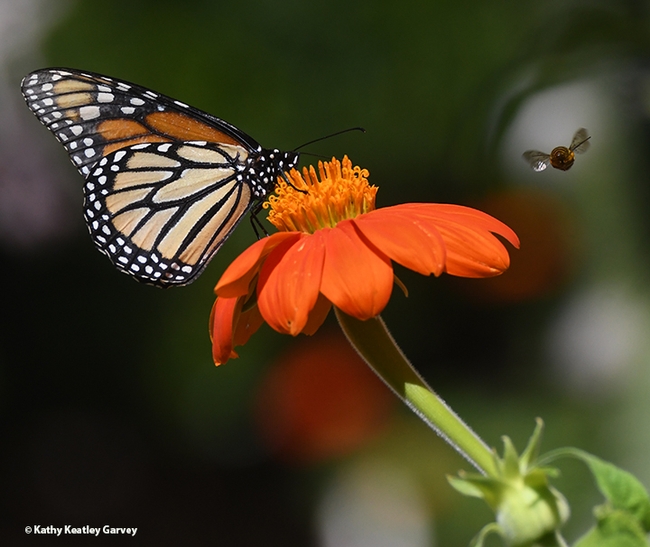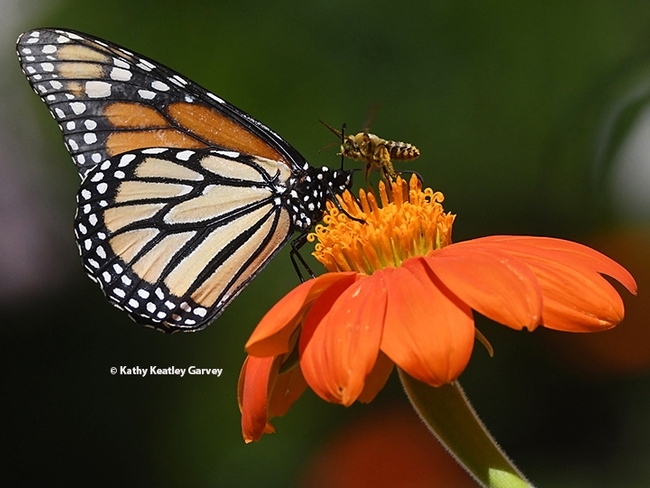Seen any monarchs lately?
No, not the British royal family: the monarch butterfly, Danaus plexippus.
Butterfly guru Art Shapiro, UC Davis distinguished professor of evolution and ecology who has monitored butterfly populations of dozens of species in the Central Valley since 1972, says it's a poor year for monarchs.
He saw one monarch on Sept. 26 in Davis, and one on Sept. 27 in West Sacramento, both Yolo County. "The coastward migration is apparently afoot...all 6 dozen of them..." he lamented.
Shapiro earlier described the monarch population as on life support. A look at this graphic on the inaturalist site helps tell the sad tale.
Maybe the U.S. Department of Fish and Wildlife will declare it an endangered species?
From its website: "On December 15, 2020, the U.S. Fish and Wildlife Service announced that listing the monarch as endangered or threatened under the Endangered Species Act is warranted, but precluded by higher priority listing actions. The decision is the result of an extensive status review of the monarch that compiled and assessed the monarch's current and future status. The monarch is now a candidate under the Endangered Species Act; we will review its status annually until a listing decision is made."
The first five paragraphs of their news release, issued Dec. 15, 2020: "After a thorough assessment of the monarch butterfly's status, the U.S. Fish and Wildlife Service (Service) has found that adding the monarch butterfly to the list of threatened and endangered species is warranted but precluded by work on higher-priority listing actions. With this decision, the monarch becomes a candidate for listing under the Endangered Species Act (ESA), and its status will be reviewed each year until it is no longer a candidate."
“We conducted an intensive, thorough review using a rigorous, transparent science-based process and found that the monarch meets listing criteria under the Endangered Species Act. However, before we can propose listing, we must focus resources on our higher-priority listing actions,” said U.S. Fish and Wildlife Service Director Aurelia Skipwith. “While this work goes on, we are committed to our ongoing efforts with partners to conserve the monarch and its habitat at the local, regional and national levels. Our conservation goal is to improve monarch populations, and we encourage everyone to join the effort.”
“The Monarch Joint Venture is committed to continuing its conservation efforts for monarchs. Each of our partners, and many other stakeholders, come to the monarch conservation table with different approaches, audiences, strengths and opportunities to make a difference. There is a role for everyone in monarch conservation,” stated Wendy Caldwell, Executive Director, Monarch Joint Venture.
"Over the past 20 years, scientists have noted declines in North American monarchs overwintering in Mexico and California, where these butterflies cluster. Numbers in the larger eastern population are measured by the size of the area they occupy. At a density of roughly 8.5 million monarchs per acre, it is estimated that the eastern population fell from about 384 million in 1996 to a low of 14 million in 2013. The population in 2019 was about 60 million. The western population, located in California, saw a more precipitous decline, from about 1.2 million in 1997 to fewer than 30,000 in 2019."
"In 2014, the Service received a petition to list the species and published a substantial 90-day finding in December 2014. In 2016, the agency began an in-depth status assessment, looking at the global population as well as focusing on monarchs in North America, where 90% of the world's population occurs."
Meanwhile, the tally of sightings in the Yolo-Solano area is troubling. Beyond troubling....
Attached Images:

A territorial male bee, Melissodes agilis, targets a monarch nectaring on a Mexican sunflower, Tithonia rotundifola, in July 2020 in Vacaville, Calif. (Photo by Kathy Keatley Garvey)

A territorial male bee, Melissodes agilis, confronts a monarch nectaring on a Mexican sunflower, Tithonia rotundifola, in July 2020, in Vacaville, Calif. (Photo by Kathy Keatley Garvey)